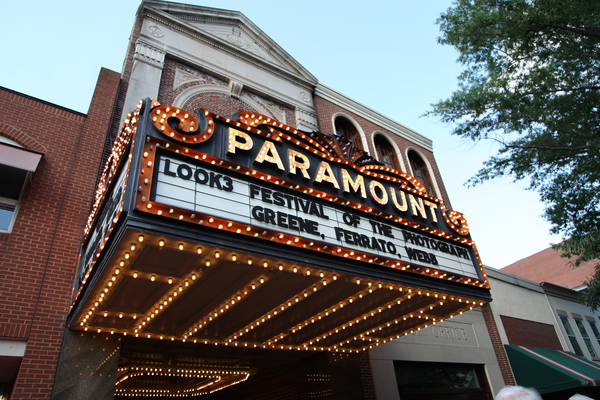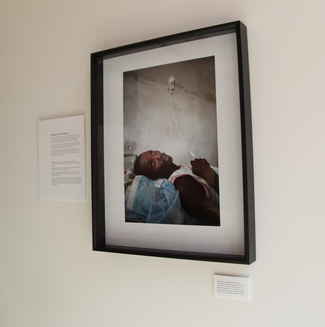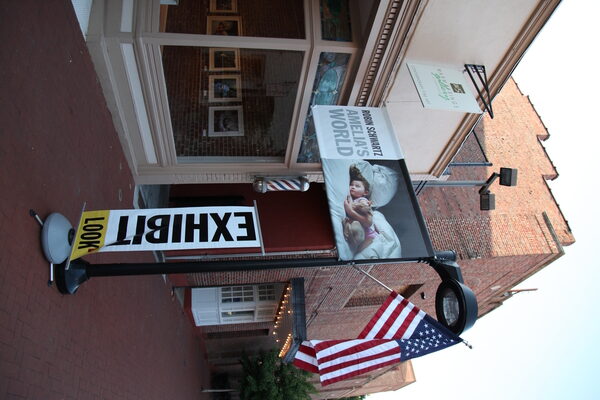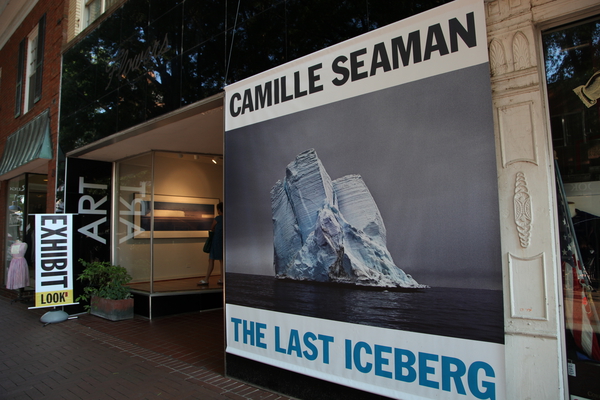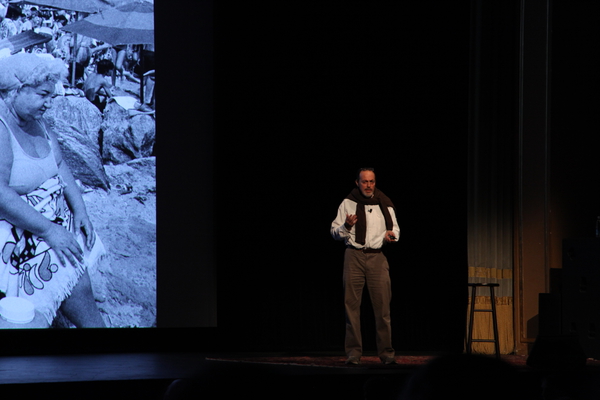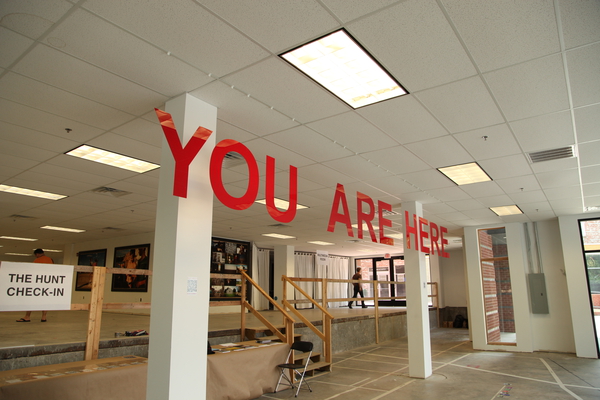Share
The Look3 Festival Round-Up
Photo by Sarah Jacobs/Charlotesville welcomes LOOK3 Festival attendees. Last week, a few of us from PhotoShelter headed down to Charlottesville, Vi...
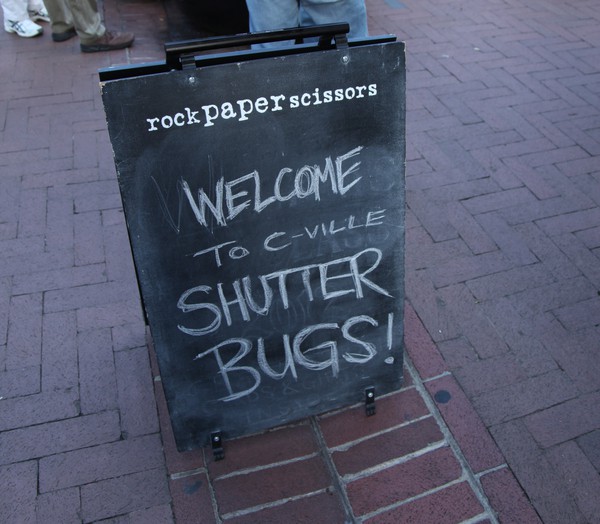
Last week, a few of us from PhotoShelter headed down to Charlottesville, Virginia for the LOOK3 Festival of the Photograph. What started in 2008 as a group of photographers gathering on Nick Nichols‘ farm to watch slideshows of each other’s images has today culminated into a near takeover of this quaint little city’s downtown.
The downtown “mall”, as the locals call it, is a eight-block stretch of pedestrian road lined with restaurants, galleries, and shops all in the quintessential, Southern colonial style. LOOK3 basically owns this central area during the festival: galleries display presenting artists’ work; restaurants are packed with people sporting the LOOK3 badge; and the historic Paramount Theater hosts a huge audience for photographer legends – this year being Stanley Greene, Donna Ferrato, and Alex Webb as part of the INsight conversation series.
LOOK3 is energetic, lively, and remains intimate despite its fast-paced growth over in the last few years. Yet, because the majority of featured work is based in photojournalism and documentary photography, there’s a very serious and sometimes emotionally taxing undertone to some of the talks and exhibitions. This feeling came out most in presentations like Donna Ferrato‘s.
Donna was one of three INsight conversations, taking place at the Paramount Theater for a little over two hours as she and NPR radio personality Alex Chadwick spoke candidly about her decades-long career. “She has been the right person in the wrong place at the wrong time,” said Vincent Musi when he introduced Donna to the crowd.

Photo by Sarah Jacobs/Vince Musi introduces Donna Ferrato, one of three guests for the INsight conversations.
In short, Donna Ferrato is a forced to be reckoned with – without warning, she jumps out of her chair to forcibly point at one of her photographs displayed on a giant projection screen behind her; she speaks openly about how her father’s bi-polar disorder shaped her family life; and when an image of a ’70s orgy displays, Donna, herself naked, says, “I’m naked, so what? I didn’t want to be a freak with my clothes on.”
Outspoken and wonderfully crass, Donna captures an audience with her vigor and liveliness. On her photographic career she said, “I had no motive besides having fun and hanging out with people…People are excited to open up to you if it’s meant to be. People want to be studied.” Much of Donna’s work over the years has focused on domestic violence, and has been showcased in magazines and advertisements to call attention to the issue at hand. In fact, one of her first photographs for the series was of a domestic dispute between a friend and her husband, who smacked her around for hiding his cocaine. The talk ended with her most recent work in Tribeca, which abides by her “I don’t wait for an introduction to take a picture” attitude.
The second INsight conversation we attended was with Alex Webb (we unfortunately missed the conversation with Stanley Greene the first day), who spoke onstage with British journalist Geoff Dyer. We were ecstatic to see Alex, but were a little thrown off by the totally different tone of the talk. Where Donna was animated and provocative, Alex was demure and had to be prodded by the equally somber Geoff Dyer. Dyer also made his respect and love (obsession?) for Alex’s work clear again and again, which took something away from the conversation.
“Alex is always seeing what can’t be seen,” said Vince in his introduction, which rings true when you view pieces from his life’s work displayed chronologically on screen. Seemingly simple, Alex’s images always have a more complex story behind them – I just wish Alex had shared more candid stories or Dyer had at least questioned him well enough to get it out. In all fairness, Alex’s mother had passed somewhat unexpectedly a few weeks prior and it was clearly weighing on him.
Alex started by sharing some of his first black and white photographs from the ’70s of the Mississippi Delta, and his first trips to Haiti and the U.S.-Mexico border. Since 1975, Alex has photographed almost entirely in color saying, “Color brings emotion to an image, and that’s what I started to look for…that emotional component.” Whether it’s a sidewalk ledge spray-painted in neon pink or a ferry wall cast in green-blue color, there are always pieces of color that draw you into Alex’s images.
The best part of Alex’s talk was that he shared photos from his entire photographic career including Haiti, Florida, Paraguay, Cuba, Istanbul, and Mexico. But it was all a little dry, and we wanted to hear more about his experiences – fewer images and more storytelling would have been ideal. Toward the end of the presentation, Alex gave his thoughts on going digital: “The difference between film and digital is that [with film] you had no idea if you captured the shot. There was time and mystery in waiting for the negatives.”
Early on Saturday morning, we made a point to see Eugene Richards speak as part of medical technology company BD’s Hope for a Healthy World breakfast. BD, which manufactures medical supplies, has been involved with LOOK3 since 2009 through their Hope for a Healthy World Photography Competition, which invites photographers to submit imagery on a wide variety of global health topics. “The power of a photograph cannot be overstated, and BD relies on imagery to tell stories about a wide range of diseases,” said global communications director Dan Grimm.
Winners from the photo contest were displayed in this year’s exhibit at LOOK3, and included Maxim Dondyuk‘s work on the TB epidemic in Ukraine; Ben Depp for his images of Cholera in Haiti; Ami Vitale for her multimedia work on maternal and infant mortality in Sierra Leone; Brent Stirton for his story on HIV in Ukraine; and Fauzan Ijazah‘s image showcasing hygiene promotion in Pakistan.
Eugene Richards’ presentation was easily the most moving – and heart-wrenching – of everything we saw. Eugene is perhaps known best for his series and book Dorchester Days, which chronicles the dramatic changes that his racially diverse hometown underwent in the ’70s. But in this talk he shared four extremely impressive and unsettling multimedia projects on global health issues. The first was of a totally desecrate psychiatric hospital in Mexico – black and white stills and video danced across the screen as wails and cries from the patients made for background noise, while Eugene described the hospital’s horrifying conditions. Absolutely nightmarish, you didn’t want to believe what was going on on-screen was real.
Another of Eugene’s videos was the result of a fundraising project for the Incarnation Children’s Center in Harlem, New York, which provides specialized care for children living with HIV/AIDs (usually as a result of being born to infected mothers who cannot care for them). You have to heartless not to tear up upon seeing some of these severely disabled, but still smiling, children as the narrator rattles off all the medications that they have to take on a daily basis. The video is a success because the sadness of the kids’ situation tugs at your heartstrings – yet you remain hopeful because of the center’s amazing care. The final shot is of sing-a-long time at the center where the kids laugh and dance, and you realize at the end of the day, they’re just children who need our help.

Photo by Sarah Jacobs/Eugene Richards signs a copy of his book after his presentation at the Hope for a Healthy World breakfast.
That afternoon had a slightly lighter tone with the Masters Talks, which featured four speakers from the artists who hosted workshops as part of the Master Classes. It included Cause Collective, a team of artists who create innovative art in the public realm. Cause Collective brought “The Truth” project to LOOK3, which is essentially a giant blow up that was traveling all over Ireland to ask people, “What is the truth?”. The bubble is outfitted with a small “room” where people can record their answer to question. The answers were everything from inspiring to funny to thought-provoking – find out more and see some of the video here.
Next up was photographer Robin Schwartz, who is famous for her series “Amelia’s World” – photos of her daughter Amelia with a wide variety of animals. Robin has been photographing her daughter with monkeys, cats, kangaroos, tigers, and more since she was a young girl. “She doesn’t do anything special,” said Robin of her daughter. “Animals trust her. She has the ability to lull them without trying.” You might recognize “Amelia’s World” for the Lens Blog, but check out her portfolio here.
Camille Seaman followed, who told an incredible story of her trip to the Arctic and where she got her inspiration to photograph the icebergs. Her panoramic images are awe-inspiring, and definitely worth a look.
The final speaker of the Master Talks was street photographer Bruce Gilden. Bruce is a straight-shooter and takes no crap from anyone. He’ll tell you that he loves a picture of the saddest things, like the temporary housing that took over Haiti after the earthquake. When speaking about his work on Coney Island, he’s not afraid to judge the fat lady in a bikini or crazy homeless man wandering the streets. Bruce is refreshingly real, and his photographs reflect that. You can read more about Bruce’s work on home foreclosures in PhotoShelter’s guide on Crowdfunding Your Photography Project.
Before we said goodbye to Charlottesville, we had to see our friends at LUCEO. Never one to disappoint, the LUCEO cooperative had the most interactive and creative exhibit – hands down. The premise was THE HUNT: instead of simply hanging up their images on the wall, Kendrick and the rest of the team divided each image into parts and hid clues to their whereabouts throughout the downtown area. The community was asked to register to receive clues, which would lead them to coffee shops, galleries, and other establishments that would pass off a part of the image.
It all culminated in the YOU ARE HERE party on Friday night, where all the images and their parts were put up on the wall for the exhibition and celebration. The images and a multimedia project were drawn from LUCEO’s “Few & Far Between” project, which focuses on industrial and population changes in rural America. The team traveled together by RV to talk to residents, get their perspective on the so-called dwindling rural America, and document it all along the way.
The other awesome component of LUCEO’s LOOK3 exhibit was THE HUB – a real-time social media feed that let festival goers send Instagram photos to be put on a live-updating map. If you weren’t at LOOK3, then THE HUB is a must-see to get the inside look. I asked Kendrick Brinson, who handles LUCEO’s social media presence, to describe why LUCEO comes to LOOK3 year after year and what sets it apart from other photo festivals. “LOOK3 fosters creativity,” she said. “We get support from the Charlotesville community, individual photographers, and the festival itself. LUCEO is a collaborative so we want to be interactive, and LOOK3 lets us include the community and engage people in a new way.”
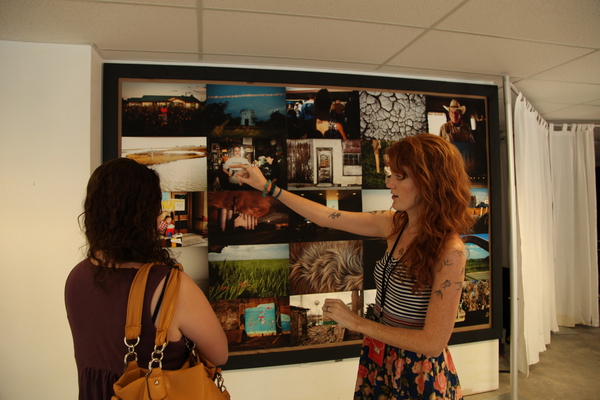
Photo by Sarah Jacobs/LUCEO photographer Kendrick Brinson shows an overview of the collective’s “Few & Far Between” project.
Billed as “3 days of peace, love and photography,” LOOK3 truly is a celebration of the photograph. It’s inspiring to see a group of photographers come together to support their craft and innovate on new ways to keep it going. From the looks of it, the festival is only going to grow into an event greater event – and we’ll be there to check it out.
All images included in this post were by PhotoShelter team member and photographer Sarah Jacobs – check out her website at sarahjacobs.photoshelter.com.

